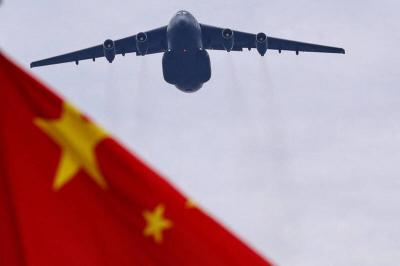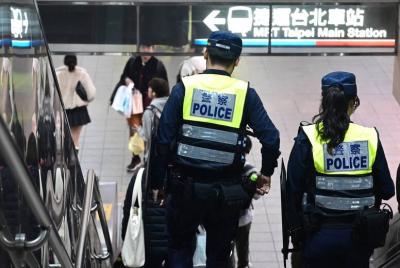It is “very important” for Taiwan to increase its defense spending, a key US Congressional staff member told a Heritage Foundation discussion on Thursday.
US Senate Armed Services Committee staff member Eric Sayers said that committee chairman US Senator John McCain stressed the issue in talks with President Tsai Ing-wen (蔡英文) in Taipei earlier this month.
He said that McCain reassured Tsai about the US’ commitment to Taiwan’s security and helping Taiwan enter the Trans Pacific Partnership (TPP) free-trade agreement.
“We want to continually raise the importance of Taipei increasing its defense spending,” Sayers told the “View from Capitol Hill” discussion organized by Heritage director of Asian Studies Walter Lohman.
Sayers said that Taiwan’s spending of about 2.1 percent of GDP or about US$11 billion per year simply did not match China’s growth rate.
He said that while no one expected Taiwan to match China’s military spending, it was vital that Taipei finds a way to increase its defense budget.
Sayers suggested that Taiwan might have to move away from buying expensive fighter planes and move toward a larger arsenal of ground-to-air missiles.
He praised the Taiwanese navy for developing its own indigenous fast attack ships, catamarans and cruise missiles.
“The cross-strait balance is a difficult balance, but it is not insurmountable if the right choices are made in investing, divesting and training,” Sayers said.
He said that weapons training and advice was as important as weapons sales.
“We can sell all the shiny capabilities we want, but it is very important that the US trains Taiwan at a very high level,” Sayers said.
Asked if the administration of US President Barack Obama was likely to send another Taiwan arms package to US Congress this year, Sayers said that there is always “talk” of a package and that discussions continued, but added that it remained uncertain.
Regarding Taiwan’s plan to build its own indigenous submarine fleet, Sayers said Taipei should be careful not to look at the issue solely as a weapons platform, but to think of it as an “anti-surface” mission, preventing attack ships from crossing the Taiwan Strait.
“Taiwan needs to think outside the box on how to do that,” he said.
Sayers said there were much cheaper options than submarines, such as naval mines.
Lohman asked if the US should rethink the way it dealt with arms sales to Taiwan and increase coordination with Taiwanese.
“It is not just about the sales, it is about engagement and bilateral coordination,” Sayers said.
He said the US had a “pretty good sense” of what Taiwan needed.
Sayers said there are about 2,600 “engagements” or meetings of various sizes and importance each year between Taiwan and the US to discuss defense issues.

Beijing could eventually see a full amphibious invasion of Taiwan as the only "prudent" way to bring about unification, the US Department of Defense said in a newly released annual report to Congress. The Pentagon's "Annual Report to Congress: Military and Security Developments Involving the People's Republic of China 2025," was in many ways similar to last year’s report but reorganized the analysis of the options China has to take over Taiwan. Generally, according to the report, Chinese leaders view the People's Liberation Army's (PLA) capabilities for a Taiwan campaign as improving, but they remain uncertain about its readiness to successfully seize

Taiwan is getting a day off on Christmas for the first time in 25 years. The change comes after opposition parties passed a law earlier this year to add or restore five public holidays, including Constitution Day, which falls on today, Dec. 25. The day marks the 1947 adoption of the constitution of the Republic of China, as the government in Taipei is formally known. Back then the Chinese Nationalist Party (KMT) governed China from Nanjing. When the KMT, now an opposition party in Taiwan, passed the legislation on holidays, it said that they would help “commemorate the history of national development.” That

Taiwan has overtaken South Korea this year in per capita income for the first time in 23 years, IMF data showed. Per capita income is a nation’s GDP divided by the total population, used to compare average wealth levels across countries. Taiwan also beat Japan this year on per capita income, after surpassing it for the first time last year, US magazine Newsweek reported yesterday. Across Asia, Taiwan ranked fourth for per capita income at US$37,827 this year due to sustained economic growth, the report said. In the top three spots were Singapore, Macau and Hong Kong, it said. South

Police today said they are stepping up patrols throughout the Taipei MRT system, after a social media user threatened to detonate a bomb at an unspecified station this afternoon. Although they strongly believe the threat to be unsubstantiated, Taipei Metro police and the Railway Police Bureau still said that security and patrols would be heightened through the system. Many copycat messages have been posted since Friday’s stabbing attacks at Taipei Main Station and near Zhongshan MRT Station that left three dead and 11 injured, police said. Last night, a Threads user in a post said they would detonate a bomb on the Taipei